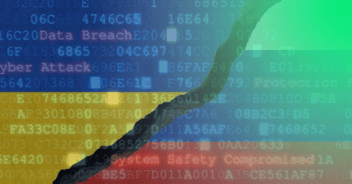The AML and Fraud MENA event, held on March 16th, 2022, brought together some of the world’s eminent thought leaders in the areas of cybercrime, anti-money laundering, and fraud. The event crystallized the state of the art in the prevention of fraud, bringing together vendors, government, regulatory authorities, and financial institutions.
Event gold sponsors, Eastnets, were proud to present at the conference. Eastnets Deputy CEO, Deya Innab, gave a passionate talk on the use of Distributed Ledger Technology (DLT) /blockchain in anti-money laundering (AML); Deya introduced the event participants to the Eastnets ChainFeed solution, a blockchain platform for watchlists screening. Here are some of the highlights of that session.
Setting the scene in numbers
Deya began the session by setting the scene in terms of financial crime costs and their impact on FIs. She told the audience the financial sector is currently spending around $108.9 billion per year attempting to combat financial crime. Coupled with this, the cost of onboarding during the pandemic increased by a staggering 170% in KYC costs. She highlighted the problem stating:
“...unfortunately, despite all this spending, and the billions of dollars that we're using to combat financial crime, only one percent of illicit funds have been intercepted by the financial institutions and, of course, this leads to the increase in financial crime”.
Deya finished setting the scene by pointing out that $2 trillion was laundered in a single year. Globally, losses due to payment fraud have tripled to over $32 billion per year since 2009; this figure will exceed $40 billion, per year, by 2027.
To compound these losses, compliance fines in 2020 cost the financial sector $10.6 billion
Does de-risking work?
Deya continued, telling the audience about the story of de-risking in the financial sector. She talks about how this strategy adopted by the financial sector to mitigate the risk at the institutional level, was counterproductive when used in isolation. One outcome of de-risking is to push customers into using deregulated financial networks such as ‘shadow banking. It creates the opposite of financial inclusion. Increasing financial exclusion harms the lives of people and harms the entire industry.
Putting the blockchain to work
Deya moved on next to talk about a solution to the problem of financial crime and AML. Deya introduced the audience to the use of blockchain in this context. She noted that this was not about cryptocurrency; this is about using a DLT (Distributed Ledger Technology) as a tool as part of an anti-money laundering strategy. Deya told the audience of two studies showing the power of blockchain in the financial sector:
Barclays Bank: a report from the bank said that permission blockchain would be a groundbreaking innovation in the AML space.
Goldman Sachs: a study found that the use of blockchain or DLT for AML compliance would save financial institutions $3-5 billion.
How would DLT/Blockchain work in AML?
Deya spoke about two use cases in the financial sector that can benefit from the use of Distributed Ledger Technology:
Customer On-boarding
Blockchain or DLT offers a common, secure, and immutable platform where you can register all the information needed to perform KYC/CDD. A DLT based KYC process provides the functions to upload, confirm, and verify data in a fully decentralized way, all done with user consent.
Deya said that “if I'm a customer and I want to open an account for the first time, I can go to the bank who then carries out the entire KYC/CDD process; all the customer’s data are collected and verified, then registered on the distributed ledger. If that customer then goes to another bank, they do not have to go through the whole process again as it is securely registered on the DLT; the bank can check if there has been any change: all banks participating in the blockchain will benefit”
The DLT backbone is extensible enough to connect trusted third-party document providers, the data being incorporated into the blockchain, benefitting both the banks and the customer. This can also act as a centralized KYC registry on a per-country basis.
Anti-Money Laundering (AML) and Counter-Terrorist Financing (CTF)
DLT and blockchain technologies benefit the areas of AML and CTF by overcoming hurdles such as false positives and the reliability of the information. A DLT is an immutable record, creating trustworthy data. Deya said, “the first step towards combating financial harm is in improving the accuracy of data and making sure it is consistent across all entities”.
Data registered on a blockchain allows both ends of a transaction to verify the data, in real-time. This allows suspicious activity to be detected, and an alert to be generated. The banks can then choose to add extra security in place, such as increasing the risk score, etc.
Deya explained how artificial intelligence (AI) is being put to work in these scenarios.
“The fact that everything is stored on the blockchain allows running advanced AI algorithms in real-time using different machine learning models on aggregated data. This is not only on individual sources of information but can utilize all available information on one platform. This delivers a powerful mechanism to detect any patterns of fraudulent activities or any attempted money laundering”.
Potentially, regulators could also be part of this collaborative blockchain, to be a proactive entity in watching out for suspicious activity.
Problems and challenges of DLT
To ensure a well-rounded discussion of the use of DLT in financial fraud prevention, Deya discussed the challenges of using DLT and blockchain. The challenges discussed were:
- No inherent truth checking depends on the banks level of KYC
- Information pollution: accumulation of errors can be a challenge
- Reliability: who has the liability for any errors?
- Trust: wide participation is key, but how do you prevent malicious entities from tricking the system?
- Privacy: by design DLT conflicts with the GDPR “right to be forgotten”. How is this fixed?
A real-life business case: ChainFeed
An Eastnets customer, already using Eastnets advanced sanction screening engine, was a first adopter of Eastnets DLT based platform, ChainFeed. Eastnets had already noted that the frequency of sanction list updates, along with how customers were handling these updates, was proving a challenge, and creating vulnerabilities. Scheduling Dow Jones updates into the Eastnets screening engine meant that if any updates occurred during the FIs experiencing a system downtime, this update would not be effectively recorded. Other issues included information in text file format, making it easily manipulated. Multiple updates from Dow Jones across associated systems that go out of sync can also lead to vulnerabilities in the system.
Eastnets have agreed with Dow Jones that these updates can now be registered to a blockchain. All subscribers to Dow Jones using the Eastnets ChainFeed screening engine will have access to this feed. Even very regular hourly updates will be immutable and available across the ecosystem.
Deya explains:
“ChainFeed means you have 100 percent assurance that you are using the most up-to-date list and you are not losing any updates. If you are a global entity with different branches and your operation is not centralized you can still be 100 percent sure that all the branches are using the same list at any point in time; not only this but the banks you are dealing with, who use the same service, ensures that there is no conflict due to different timing and different updates.”
Eastnets currently has 30 customers using ChainFeed, who can take advantage of immediate updates on the engine. The engine is fast, seamless, auditable, and time-stamped.
The cyber-fight continues
Deya concluded the session by reminding the audience that the war against financial crime continues in its complexity and intensity. She told the audience that DLT offers a way to deliver trust and immutability to the financial sector, but this must be done by sharing information and in collaboration with regulators and auditors.
- Click here to listen to the full interview with Deya Innab.
- Learn more about Eastnets ChainFeed, Real-time, blockchain-based watchlist updates, and contact us today for a free demo.





